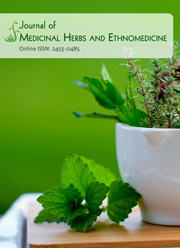Moringa oleifera extract and neostigmine confer neuroprotection on aluminium chloride -induced Alzheimer’s disease: Antioxidant and acetylcholinesterase inhibitory activities
DOI:
https://doi.org/10.25081/jmhe.2022.v8.7597Keywords:
Neurofibrillary Tangle, Chromatolysis, Pyknosis, Nissls Granule, Oxidative StressAbstract
Alzheimer’s disease (AD) is a neurological episode associated with the senescence process characterized by neuronal cell death in brain regions and loss of cognition. The study investigate the neuroprotective potentials of Moringa oleifera leaf extract and Neostigmine in a rat model of Alzheimer’s disease induced by Aluminium chloride (AlCl3). A total number of 20 rats weighing 180-240 kg were used for this study and they were grouped into 5 with 4 rats in each group (n=4) labelled A-E. Group A control, received 0.1 mL normal saline (placebo), Group B, received 100 mg/kg of Aluminium chloride, Group C was given Aluminium chloride 100 mg/kg and 200 mg/kg, Group D experimental animals received Aluminium chloride 100 mg/kg and were treated with 400 mg/kg of the extract orally for 21 days, while Group E received the same dose of Alcl3 and 2 mg/kg Neostigmine given intraperitoneal (IP). Thereafter, the rats were sacrificed, and the hippocampi were harvested for histology and histochemical analysis. Our findings revealed visible protective changes in the group treated with the M. oleifera and Neostigmine as the pyramidal cells of CA3 and neurofibrillary tangles which were prominent in the positive control group were resolved. At the end of this study, it was proven that the toxicity induced by Aluminium chloride was reduced by M. oleifera leaf extract and Neostigmine. M. oleifera is a commonly consumed plant therefore the intake should be encouraged.
Downloads
References
Akram, M., & Nawaz, A. (2017). Effects of medicinal plants on Alzheimer’s disease and memory deficits. Neural Regeneration Research, 12(4), 660-670. https://doi.org/10.4103/1673-5374.205108
Ansari, N., & Khodagholi, F. (2013). Natural products as promising drug candidates for the treatment of Alzheimer’s disease: molecular mechanism aspect. Current Neuropharmacology, 11(4), 414-429. https://doi.org/10.2174/1570159X11311040005
Bamishaiye, E. I., Olayemi, F. F., Awagu, E. F., & Bamshaiye, O. M. (2011). Proximate and Phytochemical Composition of Moringa oleifera Leaves at Three Stages of Maturation. Advance Journal of Food Science and Technology, 3(4), 233-237.
Bennett, R. N., Mellon, F. A., Foidl, N., Pratt, J. H., Dupont, M. S., Perkins, L., & Kroon, P. A. (2003). Profiling glucosinolates and phenolics in vegetative and reproductive tissues of the multi-purpose trees Moringa oleifera L. (horseradish tree) and Moringa stenopetala L. Journal of Agricultural and Food Chemistry, 51(12), 3546-3553. https://doi.org/10.1021/jf0211480
Brookmeyer, R., Johnson, E., Ziegler-Graham, K., & Arrighi, H. M. (2007). Forecasting the global burden of Alzheimer’s disease. Alzheimer’s & Dementia, 3(3), 186-191. https://doi.org/10.1016/j.jalz.2007.04.381
Doggrell, S. A., & Evans, S. (2003). Treatment of dementia with neurotransmission modulation. Expert Opinion on Investigational Drugs, 12(10), 1633-1654. https://doi.org/10.1517/13543784.12.10.1633
Fu, L.-M. & Li, J.-T. (2011). A Systematic Review of Single Chinese Herbs for Alzheimer’s Disease Treatment. Evidence-Based Complementary and Alternative Medicine, 2011, 640284. https://doi.org/10.1093/ecam/nep136
Ganguly, R., & Guha, D. (2008). Alteration of brain monoamines & EEG wave pattern in rat model of Alzheimer’s disease & protection by Moringa oleifera. The Indian Journal of Medical Research, 128(6), 744-751.
Ijeomah, A. U., Ugwuona, F. U., & Abdullahi, H. (2012). Phytochemical Composition and Antioxidant Properties of Hibiscus sabdariffa and Moringa oleifera. Nigerian Journal of Agriculture, Food and Environment, 8, 10-16.
Mattson, M. P. (2004). Pathways towards and away from Alzheimer’s disease. Nature, 430, 631-639. https://doi.org/10.1038/nature02621
Niu, H., Álvarez-Álvarez, I., Guillén-Grima, F., & Aguinaga-Ontoso, I. (2017). Prevalence and incidence of Alzheimer’s disease in Europe: A meta-analysis. Prevalencia e incidencia de la enfermedad de Alzheimer en Europa: metaanálisis. Neurologia, 32(8), 523-532. https://doi.org/10.1016/j.nrl.2016.02.016
Ozor, I. I., Agwag, Z. N., Finbarrs-Bello, E., Ozioko, O. M., Ozioko, U. S., & Iruka, N. C. (2020). The Effects of Aqueous Leave Extract of Moringa oleifera on the Hippocamppal Histology of Aluminium Chloride- Induced Alzheimer’s Disease in Adult Wistar Rats. International Journal of Neurologic Physical Therapy, 6(2), 23-28. https://doi.org/10.11648/j.ijnpt.20200602.12
Pakade, V., Cukrowska, E., & Chimuka, L. (2013). Metal and flavonol contents of Moringa oleifera grown in South Africa. South African Journal of Science, 109(3/4), 7. https://doi.org/10.1590/sajs.2013/835
Prince, M., Bryce, R., Albanese, E., Wimo, A., Ribeiro, W., & Ferri, C. P. (2013). The global prevalence of dementia: a systematic review and metaanalysis. Alzheimer’s & Dementia, 9(1), 63-75.e2. https://doi.org/10.1016/j.jalz.2012.11.007
Rizzi, L., Rosset, I., & Roriz-Cruz, M. (2014). Global epidemiology of dementia: Alzheimer’s and vascular types. BioMed Research International, 2014, 908915. https://doi.org/10.1155/2014/908915
Valls-Pedret, C., Sala-Vila, A., Serra-Mir, M., Corella, D., Torre, R. de la, Martínez-González, M. Á., Martínez-Lapiscina, E. H., Fitó, M., Pérez-Heras, A., Salas-Salvadó, J., Estruch, R., & Ros, E. (2015). Mediterranean Diet and Age-Related Cognitive Decline: A Randomized Clinical Trial. JAMA Internal Medicine, 175(7), 1094-1103. https://doi.org/10.1001/jamainternmed.2015.1668
Published
How to Cite
Issue
Section
Copyright (c) 2022 Elizabeth Finbarrs-Bello, Okamkpa Chikezie Jude, Okoro Gabriel Ekene

This work is licensed under a Creative Commons Attribution 4.0 International License.



 .
. 